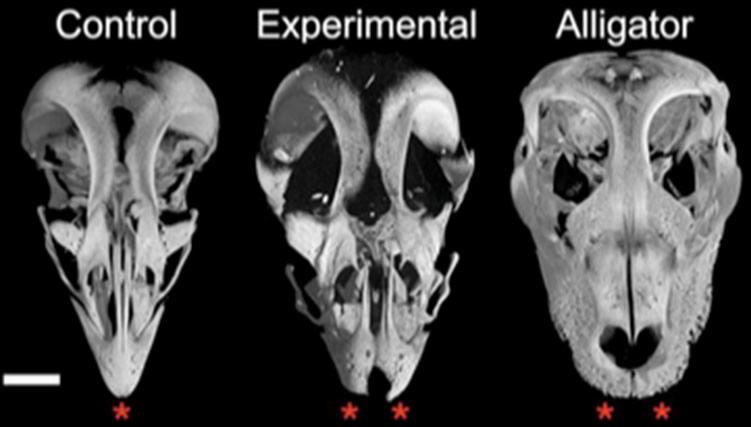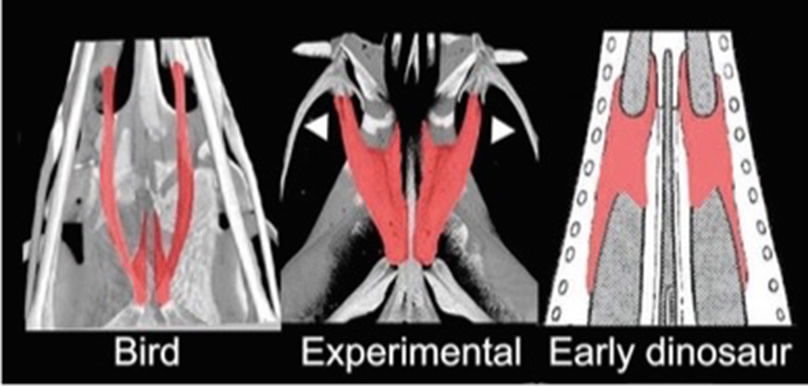
Rewinding Evolution from Bird Beak to Dinosaur Snout
News to Know
Abstract
Can reverse engineering a bird’s beak reveal evolutionary transitions?
News Sources
Evolutionary scientists say they can backtrack evolution from bird beak to dinosaur snout by preventing expression of beak-building genes in chicken embryos. They believe they have uncovered a transitional form in bird evolution. But have they actually unveiled the evolutionary default form of a bird’s mouth? Just what would be required to transform a bird into a dinosaur, and what would a step in such a direction mean?
Undoing Development
Despite recent discoveries of dinosaur soft tissue, intact dinosaur DNA likely no longer exists, making a Jurassic Park-style dinosaur resurrection a pipe dream.1 Even paleontologist Jack Horner, consultant on the Jurassic movies, says so. 2 However, evolutionary scientists from Harvard and Yale believe they have found a way to turn back the clock on bird evolution to “re-establish the ancestral condition.” 3
Yale’s Bhart-Anjan Bhullar and Harvard’s Arhat Abzhanov inhibited growth factors in chicken embryos to switch off genes for beak formation. This would, they hoped, allow the supposed ancestral dinosaur snout to form instead of the beak as a result of “ancestral gene expression.” 4 The beakless snouts on the defective birds resemble those of dinosaurs and alligators. The researchers therefore believe they have identified a dinosaur-to-bird transition not preserved in the fossil record.
Abundant Beaks
Only birds have beaks. The great variety in bird beaks enables birds to adapt to countless ecological niches around the world. Just consider “” and the beaks of the iconic Galapagos finches from which Darwin drew inspiration. Of course these finch beaks are great examples of variation within a created kind, illustrating natural selection and even unspeciation while offering no support to Darwinian evolution. Read more about the adaptability of birds in “The Big Bang of Bird Evolution?”
A bird’s upper beak is composed of two fused bones. This is true of not only living birds but also extinct birds like Hesperornis. Hesperornis had teeth as well as an upper beak and bony palate just like that of modern birds. 5 These large but lightweight fused bones are like longer, narrower versions (or homologs) of the small, unfused premaxillary bones of other vertebrates. Premaxillary bones in non-birds are the bones at the front tip of the upper jaw in which the front-most teeth are anchored. Birds also don’t have much of a hard palate, which is typically more abbreviated than the robust hard palate of other vertebrates.
Unbuilding a Beak
Without a beak there can be no bird, and evolutionists generally believe that premaxillary bones in non-bird ancestors lengthened and fused to form the bird’s upper beak early in the evolutionary history of birds. The fossil record does not contain any record of this transition. Bhullar and Abzhanov claim to have uncovered the genetic footprint of this crucial transition. The researchers believe the original dinosaur genes lurking unexpressed in bird genomes can be unveiled in bird embryos if bird traits like beaks remain unexpressed.
Bhullar and Abzhanov sabotaged beak development to see what would grow in its place. “It shouldn’t produce some kind of monster,” 6 Bhullar said, but instead should in essence reverse evolution and reveal the face of the chicken’s ancestor. Bhullar and Abzhanov did not tinker with the chicken genome. Instead they poisoned two gene products—transcription factors, which regulate expression of other genes—associated with beak development. These transcription factors also regulate the expression of other genes, so they inserted inhibitors only in the large patch of cells where the face forms. There, these proteins—Fibroblast growth factor 8 (Fgf8) and Lymphoid enhancer-binding factor 1 (Lef1)—act as switches that turn on genes for beak formation. They are also found in embryos7 of many other kinds of vertebrates8—including humans, mice, turtles, and crocodiles—but in non-bird embryonic faces they are usually found in two small patches of cells.

Scale bar = 1 cm; From B-A Bhullar et al., “A Molecular Mechanism . . . ” doi:10.1111/evo.12684.
The experimental chickens did not develop upper beaks. Instead, Bhullar and Abzhanov report their premaxillary bones looked like the unfused bones of alligator or dinosaur snouts, as shown in these photographs.

From B-A Bhullar et al., “A Molecular Mechanism . . .” doi:10.1111/evo.12684.
The bony palate in the experimental embryos was also more like the palate of an “early dinosaur” snout than a chicken’s. (Palatine bones are indicated by red in this illustration.) They believe that other transitional steps in the complex evolution of the beak remain to be discovered, but like Jack Horner they believe that genetic manipulation of bird embryos can rewind evolution9 and demonstrate the mechanisms of evolution. They believe they can “manipulate a chicken embryo to awaken the dinosaur within.” 10 Bhullar and Abzhanov explain how, in their view, their study reveals transitional forms that are missing from the fossil record:
The approach we demonstrate here, which explicitly “closes the circle” by including lab-generated phenotypes in the same analysis as fossil forms, can serve as a model for future investigations of macroevolutionary transformations inferred from the rock record. One of the most important aspects of the current approach is the recognition that evolutionary developmental transitions are single historical events. 11
They further propose that this method be used to define the many missing links in the fossil record and believe it to be more accurate than simply imagining what transitions should look like:
Thus, functional tests should be constrained by inferred ancestral states of gene expression or other developmental processes on both sides of the major anatomical transformation. This stands opposed to a blind search for phenocopies that merely resemble various morphologies. Undoubtedly in most cases there are many potential mechanisms that generate similar morphological shifts to a historical transition, but only one of these actually was responsible for the transformation. The precise historical mechanism is discoverable if embryonic material is available from extant taxa on both sides of the change. 12
Snout’s Not Evolution
The study’s authors consider their method a more reliable way to discover transitional forms than the usual method of lining up fossil shapes in a “search for phenocopies that merely resemble various morphologies.” It is worth noting, however, that they consider their method to have accurately rewound evolution because the defective chicken embryos resemble various morphologies in animals that they already assume to be birds’ evolutionary cousins and ancestors. Their reasoning is circular at best.
According to Jack Horner, author of How to Build a Dinosaur: Extinction Doesn’t Have to Be Forever, this study is “proof of concept” that reverse engineering a dinosaur from bird DNA is feasible. 13 “It all started with ‘Jurassic Park,’” Horner says. However, he explains, “If you did the thing they did in ‘Jurassic Park,’ [filling in the missing pieces with frog DNA], you’d basically have a frog.” 14 Despite this, Horner thinks it is possible to reverse engineer dinosaur DNA from chicken DNA because he, like many evolutionists, believes birds (unlike frogs) are direct descendants of “non-avian dinosaurs.” Horner himself has long been engaged in research to determine what sorts of genetic alterations in chickens might produce some sort of animal that looks like a dinosaur. You can read more about this in “Jurassic Spark? Hatching Dinosaurs from Chicken Eggs?”
Much of what is today assumed to be true of dinosaurs is based on evolutionary conjecture.
Much of what is today assumed to be true of dinosaurs is based on evolutionary conjecture. For instance, though the fossil record does not reveal an evolutionary progression in feather development, evolutionary scientists assume that fibers found on some dinosaur fossils represent early stages in feather evolution and encourage artists to depict dinosaurs covered with feathers. Fossils cannot walk for us, but scientists claim to have discovered how T. rex walked by tacking tails onto chickens, believed to be great dinosaur stand-ins on the basis of their presumed ancestral relationship. (Read about it in “Do Tacked-on Chicken Tails Tell How T-rex Walked?”)
Embryonic research with the express purpose of unveiling the bird’s ancestral dinosaur is particularly important to evolutionists who desire to have their beliefs accepted by all. As Horner explained in “The Quest to Build a Dinosaur” in Maclean’s Magazine, “You can’t make a dinosaur out of a chicken, if evolution doesn’t work.” 15 In other words, Horner and his colleague Hans Larsson began their own efforts to produce dinosaur-like chickens by flipping genetic switches in order to “spark . . . a public debate about evolution by winding its tape backwards for all to see.” 16 Commenting on the early stages of Abhanov’s research, New Scientist editorialized, “As a bonus, this research undermines creationist arguments about the impossibility of large-scale evolutionary changes. Who could possibly argue with that?” 17
Engineering, Not Reverse Engineering!
Rewinding evolution through tinkering with bird embryos would, according to Horner, prove evolution happened in the first place. Some assert that the evolution of one organism into another is a matter of flipping a few switches. But developmental biologist Ralph S. Marcucio of the University of California, San Francisco, suggests this approach oversimplifies the complexity of genetic regulation. He says, “It’s a simple kind of thing, but when you look at the actual pieces of data, it tends to fall apart. It takes away from the complexity that’s the reality.” 18
God our Common Designer used many of the same gene sequences fine-tuned by complex gene regulators to produce very different kinds of creatures. 19 These gene regulators are not agents that allow evolution, however, for observational biology reveals that organisms only reproduce and vary within their created kinds. Observational biology fails to support molecules-to-man evolution and instead illustrates God’s “reproduce after their kind” statements in Genesis 1.
These defective chicken embryos were not transitional forms, and they did not revert to their ancestral condition. Default dinosaur DNA did not direct their development. What did direct their development was a great deal of intelligence on the part of the Dr. Abzhanov, Dr. Bhullar, and their colleagues. To achieve a targeted embryonic defect like this, even one that so loosely and imperfectly resembles the bone structure of another sort of animal, required an enormous amount of research and experimentation. Insertion of the correct inhibitors at the correct spot in the embryo at precisely the right time in its development to inhibit specific genetic expression and achieve the desired effect was not accomplished through random processes. And as the researchers freely admit, they only targeted one small part of the animal’s anatomy, not the countless changes that would be required to engineer a dinosaur-like animal from a bird embryo. But note we use the word engineer, not reverse engineer! The ability to do this sort of procedure in no way demonstrates that random natural processes did or could ever transform an animal into some other kind of animal. It illustrates just the opposite!
Genetically engineering a bird’s genome to get an animal that looks like another sort of animal would, comments Answers in Genesis research biologist Dr. Nathaniel Jeanson,20 require a phenomenal number of “deliberately designed, carefully planned, intelligently constructed manipulations to the genome, which proves that enormous intelligence is required to transform one kind into another. Not so good for evolution, which requires unintelligent and strictly natural processes to work!” The evolutionary scientists are intelligently targeting a part of embryonic development and genetic expression that would be a key change if a bird were to evolve from a reptile. “But,” Dr. Jeanson adds, “they don’t realize how much their results underscore the biblical position that kinds don’t naturally transform into other kinds, and they fail to recognize how much the results also demonstrate that only a Super-Intelligence could have created the creatures in the first place.”
Furthermore, this paleo-embryonic approach to origins science still begs the question of where any of that information—information to code for proteins or to coordinate genetic expression—came from in the first place. Observational science supports not tales of evolutionary transitions but instead affirms God’s eyewitness account of the origin of birds on the fifth day of creation about 6,000 years ago:
Then God said, “Let the waters abound with an abundance of living creatures, and let birds fly above the earth across the face of the firmament of the heavens.” So God created great sea creatures and every living thing that moves, with which the waters abounded, according to their kind, and every winged bird according to its kind. And God saw that it was good. And God blessed them, saying, “Be fruitful and multiply, and fill the waters in the seas, and let birds multiply on the earth.” So the evening and the morning were the fifth day. (Genesis 1:20–23)
Further Reading
For More Information: Get Answers
Remember, if you see a news story that might merit some attention, let us know about it! (Note: if the story originates from the Associated Press, FOX News, MSNBC, the New York Times, or another major national media outlet, we will most likely have already heard about it.) And thanks to all of our readers who have submitted great news tips to us. If you didn’t catch all the latest News to Know, why not take a look to see what you’ve missed?
(Please note that links will take you directly to the source. Answers in Genesis is not responsible for content on the websites to which we refer. For more information, please see our Privacy Policy.)
Footnotes
- DNA is a fairly fragile molecule. Nevertheless, Mary Schweitzer has been able to stain what seem to be fragments of DNA in dinosaur bone cells. However, without being able to sequence it and without having anything known to be dinosaur DNA for comparison, its identity remains unconfirmed. Read more about it in “Preserved Cretaceous Collagen and Dinosaur Blood: Common Clues to a Catastrophic Past?.”
- Kevin Loria, “The Paleontologist Who Worked on ‘Jurassic World’ Is Trying to Create a Real Dinosaur Within 5 to 10 Years,” Business Insider, June 4, 2015, http://www.businessinsider.com/the-paleontologist-who-worked-on-jurassic-world-is-trying-to-create-a-real-dinosaur-within-5-to-10-years-2015-6.
- B-A Bhullar et al., “A Molecular Mechanism for the Origin of a Key Evolutionary Innovation, the Bird Beak and Palate, Revealed by an Integrative Approach to Major Transitions in Vertebrate History,” Evolution, (2015), doi:10.1111/evo.12684.
- Ibid.
- Ibid.
- Carl Zimmer, “Reverse Engineering Birds’ Beaks into Dinosaur Bones,” The New York Times, May 12, 2015, http://www.nytimes.com/2015/05/12/science/reverse-engineering-birds-beaks-into-dinosaur-bones.html.
- Fibroblast growth factor is also involved in development at other locations, such as the limbs and midbrain of embryonic mice and chickens. Fibroblast growth factor, important as it is for embryonic development, continues to have a role in adult vertebrates also. For instance, the gene encoding it is expressed in adult human ovaries and testes. Lymphoid enhancer-binding factor 1 is protein that regulates gene transcription in many adult and embryonic vertebrates. In humans, mutations in the gene encoding Lef1 have been implicated in some forms of cancer.
- Similar proteins and therefore similar genes are found in many different kinds of organisms, but this finding is explained by the fact that all living things share a similar biochemistry, have similar basic needs, and were designed by a common Creator, the common Designer of all. Thus it is no surprise to find that many of the same proteins such as the regulatory proteins in embryonic faces are found in many different kinds of animals.
- See for instance Sujata Gupta, “Reverse Evolution: Chicken Revisits Its Dinosaur Past,” New Scientist 2826 (2011): 6–7, http://www.newscientist.com/article/mg21128264.200-reverse-evolution-chicken-revisits-its-dinosaur-past.html.
- “No Need to Fear Rewinding Evolution,” New Scientist 2826 (2011), http://www.newscientist.com/article/mg21128263.300-no-need-to-fear-rewinding-evolution.html.
- B-A Bhullar et al., “A Molecular Mechanism . . .” doi:10.1111/evo.12684.
- Ibid.
- Loria, “The Paleontologist Who Worked . . .”
- Ibid.
- Kate Lunau, “The Quest to Build a Dinosaur,” Maclean’s, August 20, 2009, http://www.macleans.ca/society/life/the-quest-to-build-a-dinosaur/.
- Ibid.
- “No Need to Fear . . .” New Scientist.
- Zimmer, “Reverse Engineering . . .”
- From a creationist standpoint, the presence of many of the same gene sequences fine-tuned by complex gene regulators is easily understood. God is our Common Designer. Many proteins and other molecules show up in multiple creatures. God did not reinvent a new kind of biochemistry and all new designs for every creature. Instead He reused many good designs in different ways. Therefore, it is no surprise that some genes appear to be “cut-and-pasted” throughout the living creatures of the world.
- Answers in Genesis recently welcomed Dr. Nathaniel Jeanson to the ministry’s research staff. Dr. Jeanson holds a PhD in cell and developmental biology from Harvard University.
Recommended Resources

Answers in Genesis is an apologetics ministry, dedicated to helping Christians defend their faith and proclaim the good news of Jesus Christ.
- Customer Service 800.778.3390
- © 2024 Answers in Genesis


